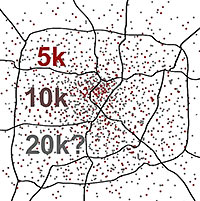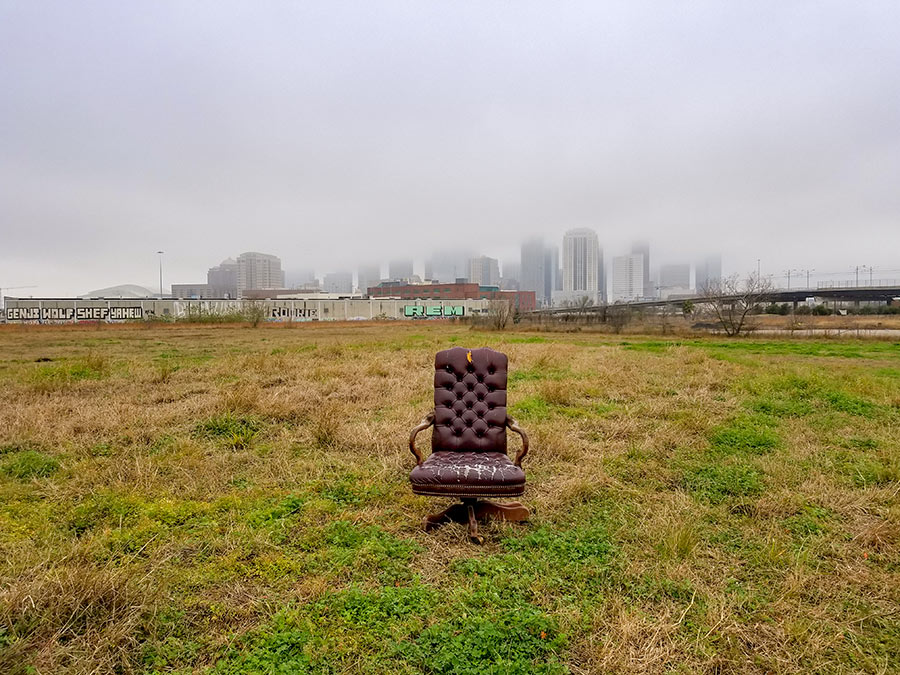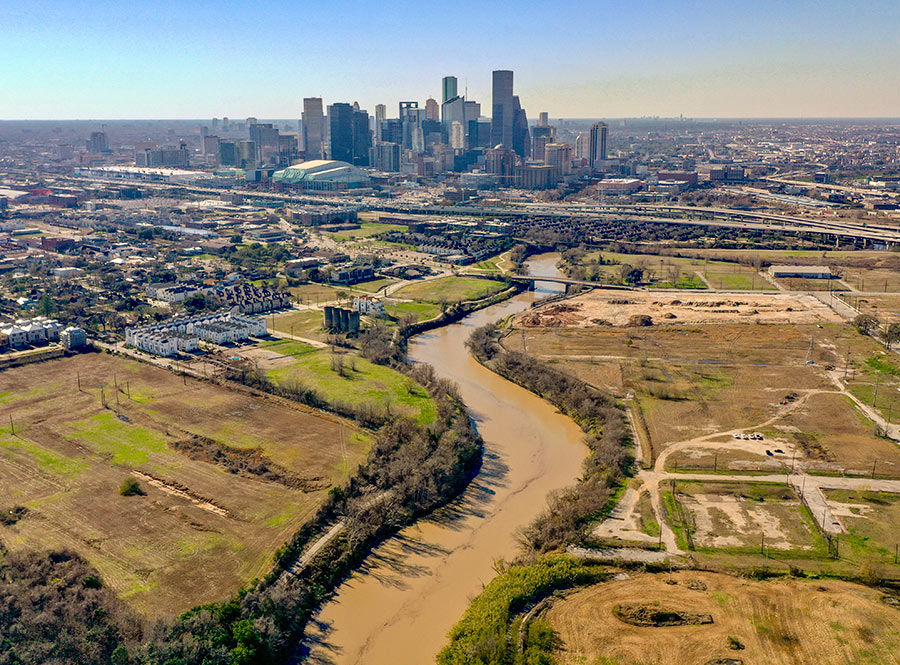COMMENT OF THE DAY: NO, SPRAWL’S NOT JUST A NUMBER AFTER ALL  “Only one of the neighborhoods cited on the ‘Houston’s not all sprawl‘ article even comes within shouting distance of what people think of when they say ‘East Coast density’ — and that’s Montrose. Two of the other neighborhoods (Gulfton and Westwood) have the residential density, but they lack the commercial density and the layout of a typical East Coast urban neighborhood. They’re basically a bunch of suburban-style apartment buildings shoved together. Pecan Park achieves its density level by cramming a lot of people into suburban-style single family houses and wasting very little space in between the suburban 5,500-sq.-ft. lots — but while it’s a cute little neighborhood, it too lacks commercial density. So basically, aside from Montrose and a couple other pockets of larger neighborhoods (i.e., northwest Midtown) there’s nothing here which even approaches a dense East Coast neighborhood, and we pretty much are all sprawl.” [Christian, commenting on Grand Central Park’s Official Debut; Houston’s Not All Sprawl] Illustration: Lulu
“Only one of the neighborhoods cited on the ‘Houston’s not all sprawl‘ article even comes within shouting distance of what people think of when they say ‘East Coast density’ — and that’s Montrose. Two of the other neighborhoods (Gulfton and Westwood) have the residential density, but they lack the commercial density and the layout of a typical East Coast urban neighborhood. They’re basically a bunch of suburban-style apartment buildings shoved together. Pecan Park achieves its density level by cramming a lot of people into suburban-style single family houses and wasting very little space in between the suburban 5,500-sq.-ft. lots — but while it’s a cute little neighborhood, it too lacks commercial density. So basically, aside from Montrose and a couple other pockets of larger neighborhoods (i.e., northwest Midtown) there’s nothing here which even approaches a dense East Coast neighborhood, and we pretty much are all sprawl.” [Christian, commenting on Grand Central Park’s Official Debut; Houston’s Not All Sprawl] Illustration: Lulu





Density means nothing if you are forced to reckon with the vehicle for every trip.
I still don’t understand the obsession with comparing Houston to East Coast / Northeastern cities. Round peg / square hole! Houston will never ever Ever EVER be like one of those cities. Micro pockets of northeastern feel or fake mini cities like City Center is all we will ever have. And to get to these micro city pockets you will need to drive. Move on and embrace Houston for being “Houston” with all of its tear down-rebuild and sprawl.
This might be one of the better comments of the day on Swamplot. Westwood and Gulfton are big thorns in the side of density in Houston. Whenever someone suggests that Houston should or will get more dense, they’re rightly confronted with the fact that Westwood and Gulfton are the City’s two densest neighborhoods, and they are certainly not examples of urban design that anyone would want to follow.
.
The point about matching residential density and commercial density is an important one to make. It confirms that “making Houston more dense” does NOT mean turning it into a giant Westwood. And that should be screamed from every mountaintop; not just in Houston but in its suburbs as well (there’s a big debate over Sugar Land’s 200 unit cap on new apartments; this plays in there).
@HouCynic
You and your proteges are the reason Houston been such a lame suburban city for soo long. Listen rural is not cool. Rurban is even worse. Urbanism is cool. This city finally caught up to the 20th century and started getting dense again. If only they had stayed dense to began with. Oh Houston why did you become so lame in the late 1960’s?! Why oh Why?! MHDA, Make Houston Dense Again.
Exactly, density should be thought of more as a self-sustainable mix of retail/office/residential and outside of Uptown I can’t think of a single area that could really meet those requirements as being self-sustaining. Everything in Houston feeds off each other.
.
And I presume that will be the case for many more decades to come. We have to first ruin all the good options before people are forced to really embrace sustainability in-place (outside of unforeseen energy price shocks which could move the needle) and there’s still tons of places left to gentrify in-town.
@Onepunchman, you’re funny. As if I or anyone else commenting on this blog have any control or influence on the rate of urbanization in Houston. I’m just calling a spade a spade. None of us will ever see Houston become a northeastern style urban city in our lifetimes. I’d also be willing to bet many in Houston are offended by the comparison anyway. Houston is Houston accept it or move away if you find Houston so lame.
@ joel: According to the Census Bureau’s LEHD OnTheMap tool, the 77056 zip code (which is a fair representation of Uptown) had 15% of its 9,120 employed residents working in the same zip code in 2014. For Houston, that is indeed pretty good. However, there are still 68,116 workers commuting in every day.
.
For comparison, 77002 (Downtown) is 16.7%, 77380 (The Woodlands – East) is 14.5%, and 77573 (League City) is 12.1%.
@Onepunchman,
Why did Houston become so lame? Blame our city’s efforts at “planning” in lieu of zoning.
In the early 70’s, due to insufficient wastewater infrastructure, the city enacted a ban on apartment buildings of more than 4 units inside the loop, driving much of apartment development to Uptown and Meyerland, and enforced a 5000 s.f. minimum lot size. This gave rise to the Montrose 4-plex, of which there are still some examples remaining, but put a cap on residential density inside the loop.
Then in the 1980’s we got 25-ft building setbacks, followed by mandatory minimum parking requirements. This added a cap on commercial density to go with the cap on residential density. The rest is history: for the next couple of decades, the car became the focal point of the built environment, and we became the low-density city we are today.
With repeal of some of the more retrograde density caps we’re starting to get some residential density, but setbacks and parking minimums are still getting in the way of the necessary commercial density needed for real walkability.
@Angostura, many of the Montrose quad-plexes long predate the 1970s. I used to live in one that was built in 1927, and on my walks around the neighborhood I pass many of ca. 1940s vintage.
@GoogleMaster, You are right. However, the 70s restrictions of new apartment and condo building inside the Loop meant that during one of Houston’s most dynamic decades, most the multifamily building was forced further out. So the smaller apartments (quadplexes and larger) in Montrose were, as you point out, mostly older than the 70s. The big apartment projects (like the Woodway Square apartments, which burned in 1979) were outside the Loop where there were no restrictions for sewer hookups.
I laugh when you mal-contents want to make Houston into a dense east coast type city. Houston is an affordable place precisely because we aren’t dense. So enjoy your affordable life style as you complain about it as well.
@WestUCoog: Low density is not the primary reason Houston is affordable. See: most low-density coastal California cities.
.
As pointed out by Kinder, Houston has had no shortage of affordable density over the years. Two to three story garden style apartments just aren’t that expensive to build, at least not the way the 1970s-80s versions were done, and as results show, they were plenty dense.
Hey, one of my properties has 56 units on 24,000 SF of land. About 430SF of dirt per door. Not bad for an 80 year old 2 story place.